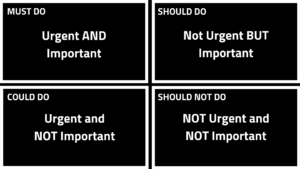
by James Duvall | Apr 4, 2020 | Productivity, Self Leadership
The coronavirus has caused life to look different over the past couple of weeks. As a result, like me, maybe working exclusively remotely for the first time for an extended period, and it can be a bit disorienting.
The lines that loosely defined the start and end of a traditional workday are blurred now more than ever. The kitchen table where you eat your breakfast and dinner now plays double duty as your desk or work station. Instead of an environment filled with peers and colleagues, who may, at times, act childish, you are continuously interrupted by your real children. And let’s face it, there is a daily temptation to replace appropriate office attire with “comfy” clothes. Even regular grooming acts of shaving for guys and applying make-up for the ladies seem less critical.
But don’t let the acclamation to this new environment cause you to back away or slow down in your forward progress. You can still be highly productive in this season, but it may take more effort and intentionality. Here are three strategies that will assist you in being productive while settling into your temporary new normal.
1. Be Consistent
Your work environment may have changed, and the work you are doing may even be different, but you have the choice to be consistent in the things that you control. Create a new rhythm. It may look slightly different, especially if you have young children you are also caring for at the same time, but make it compatible with your new work environment. Here are are few things to consider.
- Wake up at your regularly set time. You may actually find that you need a bit more time in the morning to get your workspace arranged.
- Keep a morning routine that you are familiar with; quiet time, reading, exercise, breakfast, etc.
- Get ready as if you are “going into the office.” Shower, put on something other than pajamas or sweat pants.
- Set regular working hours. Set a start and a finish to your day. Take a lunch and coffee breaks.
2. Be Persistent
James Clear, in his book Atomic Habits, says, “The most useful form of patience is persistence. Patience implies waiting for things to improve on their own. Persistence implies keeping your head down and continuing to work when things take longer than you expect.” Who knows how long we will be dealing with the effects of COVID 19. It seems like there are new assumptions made with every news cycle. We can not control the timeline of this crisis. What we can control is the effort we are going to put into moving forward with our responsibilities, our dreams, and our lives.
Focus not only on the urgent. Maintain work and persistence around those things that are also important. You may find that you have extra time during this season. Are there some large projects that you have found it hard to work on because of time? Maybe now is the opportunity to make progress. Is there a book you have wanted to write or a blog that you have wanted to start? What if the “Stay At Home” mandates are actually an unexpected gift of time? Don’t patiently wait for things to get back to normal. Be persistent to be ready to excel in the new post-COVID 19 normal.
3. Be Interdependent
One of the hardest realities of being forced to work remotely is the loss of the organic socializing that happens in an office, retail, or any other work environment. When business meetings and interactions have transitioned to primarily happening via video conferencing and phone calls, it could be easy to avoid these same mediums for relational connections. However, it is essential to leverage technology in new ways to lean into relationships. This is especially crucial for social extraverts. Intentionally simulate some phone calls or video chats with friends for the sole purpose of being relational. Set up some online coffee connections to talk about things you would usually talk about with your co-workers.
“Social separation” will probably end up being the slogan of 2020. But, maybe the focus should be called “Physical separation,” and a concentration of intentional digital “social connection” be a driving objective during this time.
The current reality of COVID 19 will pass, and life will return to normal or some version of normal. Many of us will soon re-occupy an office, cubicle, or workspace. But in the meantime, you can stay productive by focusing on being consistent, persistent, and interdependent.
The current reality of COVID 19 will pass, and life will return to normal or some version of normal. Many of us will soon re-occupy an office, cubicle, or workspace. But in the meantime, you can stay productive by focusing on being consistent, persistent, and interdependent.

by James Duvall | Oct 19, 2018 | Productivity, Self Leadership
The headline of a 2017 article of Forbes magazine referenced a study that stated time as “the most valuable commodity.” Unlike money, where there are unlimited opportunities to make more, time is a non-renewable commodity. Once time is used, it’s gone.
One of my favorite quotes about time is by AW Tozer. He said, “Time is a resource that is nonrenewable and nontransferable. You cannot store it up, slow it up, hold it up, divide it up or give it up. You can’t hoard it up or save it for a rainy day – when it’s lost it’s unrecoverable. When you kill time, remember that it has no resurrection.”
It will not surprise you, we each get the same amount of time, twenty-four hours in a day, one hundred and sixty-eight hours a week. There’s not a select group of people or location on the planet that gets more or less. It doesn’t matter how rich or poor, educated or uneducated…we all have the same amount……no more no less.
That’s why author Kevin Kruse, in his book 15 Secrets Successful People Know About Time Management: The Productivity Habits of 7 Billionaires, 13 Olympic Athletes, 29 Straight-A Students, and 239 Entrepreneurs says, “Time is unique because it’s the one true equalizer.”
The big differentiator between the “time wealthy” and the “time poor” is not the amount of time but what’s done with the time one has.
When I was a kid, every time I earned a couple of dollars, I would want to go to the store and spend it as quickly as possible. My dad would always say, the money was “burning a hole in my pocket.” I was not a good manager of money. The same could be said of many people. They blow through time, not realizing the value of it.
The truth is time cannot be managed. However, you can control what you do with the time you have. Here are three practices that, if done regularly, will keep time from “burning a hole in your pocket.”
PRIORITIZE YOUR TIME
Jason Selk in the book Organize Tomorrow Today writes, “The most successful people don’t get everything done. They get the most important things done.” But how do you determine the most important things?
Here is a framework that I have found helpful to dial in priorities.
MUST DO, SHOULD DO, COULD DO, SHOULD NOT DO
I base this framework on the Eisenhower matrix, made famous by author Stephen Covey in the Seven Habits of Highly Successful People. On a sheet of paper create a box with four quadrants. Label the top left MUST DO. Namethe bottom left, COULD DO. The top right quadrant, label SHOULD DO. Finally, name the bottom right quadrant SHOULD NOT DO.
Now, make a list of all the things you are responsible for and the way you use your time include projects you are working on, regular tasks and assignments, activities that you do on a regular basis, and goals that you want to accomplish. All items that are urgent AND important write down in the MUST DO quadrant. These activities should take first priority. They are activities that need to be dealt with immediately. The goal would be to reduce the number of items that land in this quadrant. You can cut these through prevention and preparation.
Now do move to the COULD DO quadrant. Place activities that are both urgent and NOT important. The items in this quadrant are often the result of someone else’s sense of urgency based on their priorities. Living out of this quadrant, you may feel rushed to get things done as well as a lack of satisfaction when they’re completed. Many times the tasks in this quadrant are distractions!
In the SHOULD DO quadrant write down all the things that are not urgent BUT important. The activities in this quadrant need to be your focus. These are the activities you should begin to prioritize. Too often this quadrant is pushed aside to the tyranny of the urgent. However, you can only push aside the things that matter most like relationships, health, and learning before time runs out.
Finally, put all the things are NOT urgent and NOT important in the SHOULD NOT DO quadrant. Activities in this quadrant are merely time wasters. Strive to minimize the amount of time you spend on activities falling in this quadrant.

There will be times when your priorities compete with one another; times when there simply is not enough time to accomplish the things you must do and the things you should do This is where the lens of “significance” can be helpful.
Significance takes into account the impact of the priority. To use a business concept, which priority will produce the highest ROI (Return on Investment)? One priority may have an immediate impact and seem like the thing to do. However, another activity could have a longer lasting impact and needs to take precedence.
Here’s the benefit of prioritizing your time. When you know your priorities, it gives clarity on what you say YES to and to what you say NO.
The most powerful word in your vocabulary is NO! Every time you say YES to something, you are saying NO to something else.
“YES lives in the land of NO!”
PROTECT YOUR TIME
Protecting your time is such an important practice. If you don’t protect your time, it is vulnerable to be stolen by something or someone else. You have to control what goes on your calendar and in your schedule. An excellent process for this is time (calendar) blocking.
Time blocking is a productivity practice for scheduling your time around your priorities. It does what it says; it blocks other people’s agendas that are not your priorities from getting on your calendar. Time blocking encourages discipline around your priorities. By creating a proactive schedule, you can pace your progress toward your deadlines. Time blocking gives guardrails for saying “No.”
Numerous blog posts teach the specifics of time blocking. However, let me give you a quick overview of how you can begin time-blocking your calendar.
Start with a blank calendar app or paper calendar. One of the features of most app-based calendars is the ability to mark BUSY and OUT OF OFFICE for each of your blocks, an easy “NO” without the need to say no.
Now, begin by putting your priorities (commonly referred to as “Big Rocks”) on your calendar. Include your standing appointments, items from your “should do” quadrant, family vacations or personal trips, etc. Block out the time or the day(s) needed for each.
“Spending your time on paper before the week begins makes all the difference in how your weekends!” — Teresa McCloy
Next, fill in the blanks. These are your “must do’s” and “could do’s.” Teresa McCloy, A friend of mine, teaches four P’S for Time Blocking; project, process (preparation), people, and presence (Mindfulness) blocks. I like to add a fifth “p,” play blocks (you can’t be productive 24/7).
You can personalize your time blocking system in ways that work for you. I like to use color coding, labeling and adding travel time to activities or events.
Here is a statement you should remember and take to heart. If it doesn’t make it on your calendar, it probably won’t make it in your life.
MAXIMIZE YOUR TIME
The third way to move from time poor to time wealthy is to practice mastering your time, which is about thinking in smaller units of time. One of the characteristics of highly productive and successful people is that they focus on minutes where most people focus on hours.
There is a principle called “Parkinson’s Law” that says work expands to fill the time available for its completion definition. If yourself 3 hours to accomplish a task, it will take you the entire 3 hours to complete. However, if you give yourself 30 minutes to finish the same project, you will get it done in 30 minutes.
Here are two things you can start doing immediately to maximize your time.
COMPRESS TO PROGRESS
Our default is to think in a half-hour or hour chunks of time. What would happen if you began to reduce your default thinking to smaller segments of time? Imagine what you could accomplish. An easy way to start compressing time is by changing the defaults. Instead of scheduling a meeting for one hour, compress it to 45 minutes. In the same way, shorten a 30minute meeting to 20 minutes. Put Parkinson’s Law into practice with any project, assignment or task.
BE PREPARED
There are always unexpected, unscheduled chunks of time that pop up during the day. What do you do with that time? A lot of people take the opportunity to exhale, spend a few minutes chatting with co-workers, surf the web, or check out their Facebook, LinkedIn or Instagram feed.
Don’t be like other people. Be prepared to maximize those soft spots in your schedule with something productive. Determine the minimum amount of time needed to accomplish something on your task list. It could be as few as 2 minutes. If a meeting ends early and you have 15-minutes of freed up time, or something gets canceled last minute on your calendar go to your list of tasks find the most important things you can knock out in that freed up window and just like that, you have won back time by being prepared.
My favorite tool for being prepared is Nozbe. Where ever I am, I have my current task and project list with me on my phone. I can see what priorities I need to accomplish, the amount of time I have projected each task to take, and the resources I need to complete them. So, if I find myself with unexpected time, I can see the tasks that I can accomplish in the amount of time I have, in the place I am, with the resources (phone, computer, etc.) I have.
I once heard it said that if you master your minutes, you can master your life. Kevin Kruse reminds us that each of us only gets 1440 minutes each day. By applying the three strategies of prioritizing, protecting and maximizing your time you can avoid losing time and use the time given to you effectively.
[et_bloom_inline optin_id=”optin_3″]

by James Duvall | Aug 17, 2018 | Personal Development, Productivity, Self Leadership
Thanks for checking out another installment of Provertivity, where I take a proverb or wise saying and combine it with a productivity principle. I really appreciate your comments and encouragement. If you have a proverb/wise saying that you would want to be considered for a future blog post, add it to the comments below.
I love the book of Proverbs. It is full of wisdom for today. Proverb 15:22 is a great proverb. I like how another version of this proverb reads,
Your plans will fall apart right in front of you if you fail to get good advice. But if you first seek out multiple counselors, you’ll watch your plans succeed.” We all want to find success. Whether that is in our relationships, business, finances, or health, the goal is to succeed, not fail.
My wife Lisa and I have the privilege of working with couples who are getting ready for marriage. One of the first things we share with them is this proverb. Why, because we know that marriage is beautiful but sometimes challenging. Having wise counsel when things get tough or when new seasons emerge is so vital to the success of a marriage relationship and any other endeavor in which we invest ourselves.
You have probably heard the adage, “Learn from mentors or learn from mistakes.” I have personally found it less painful and more productive to learn from mentors. There is a perspective that comes with experience. And failure to tap into that perspective will, as the proverb says, lead to failed plans.
Here’s some hard truth; You are good, but probably not good enough to make it on your ingenuity alone. Everyone needs other people who have greater wisdom or insight. We all need the voice of those who have previously traveled the road we are on to help us avoid the pitfalls that may lie ahead.
Nothing can kill effectiveness and forward progress like doing things inefficiently or making bad decisions that cost time and resources. You can have the grandest plans but have weak strategies and systems to make them happen. Having the right counsel can increase the odds of success.
The proverb says that with “many advisors” there is success. So, here are five types of advisors that you can leverage as you move forward in your life.
Accountability Partner
Everyone needs accountability. We all need checks and balances to push us to be our best self. A lack of personal accountability can lead to the inevitable and sometimes devastating consequences that result from living an unhealthy and unchecked life. An accountability partner will call you out on broken promises and the failure to keep commitments. Making yourself accountable to trusted people can be a safety net from making wrong decisions that lead to failure.
Mentor/Coach
As Bill Gates put it, “Everyone needs a coach.” The good news is that coaching is becoming increasingly more accessible. A coach is going to be objective, knowledgeable, skilled in listening, and someone who cares. A good coach will ask the right questions and sometimes the hard questions. A good coach will provide honest feedback and helpful insight. The right coach can be a guide in providing the direction and tools needed for growth and finding the right path forward. You may need a coach for a specific area where you are hitting a lid or in areas where you do not see the growth you desire. These could be in areas like spiritual growth, health, finances, relationships or productivity.
Counselor/Therapist
You may be thinking, isn’t a counselor and a coach the same thing. No. A coach focuses on helping people achieve their goals, giving motivation for, and creating plans for change. A counselor works with people to solve the problems that make them feel bad emotionally or keep them from functioning well. There are times when we need to get help overcoming issues from our history that hold us back from moving forward into our destiny. Anxiety, depression, and many other emotional matters require the services of a trained professional counselor to move forward.
Expert
Who are the people already doing what you want to do at a higher level than what you are currently doing it? For most of us, we will never have the opportunity to meet and get direct counsel from these people in a face to face setting. However, many experts make their counsel and advice readily accessible through the books they have written, blogs and podcasts that they have posted online and seminars that they teach. Today, you can leverage most experts on demand, twenty-four, seven.
Wise Sage
Merriam-Webster defines a sage as a person of great understanding of people and of situations and an unusual discernment and judgment in dealing with them. A wise sage is a person farther down the road than you who has through reflection and experience, greater wisdom and insight about life and how to be successful at it. When I think of a wise sage, I think of Mr. Myogi from the Karate Kid movies. More than teaching Daniel LaRusso karate, he taught him how to live a better life (wax on wax off).
Life can be challenging and complicated at times. Getting the right voices around you is so important if you are going to succeed. History is littered with people who failed due to inadequate or no counsel. Recently I heard Brian Houston, Senior Pastor of Hillsong Church say, “There is a big difference between opinion and good counsel. Opinion is forced on you; counsel is invited.” I encourage you to think about the “advisors” you have around you. Maybe it is time to add to your “many advisors” and invite the voice of an accountability partner, coach, counselor, expert or wise sage to speak into your reality and enjoy the success that results from the input.
[et_bloom_inline optin_id=”optin_3″]










